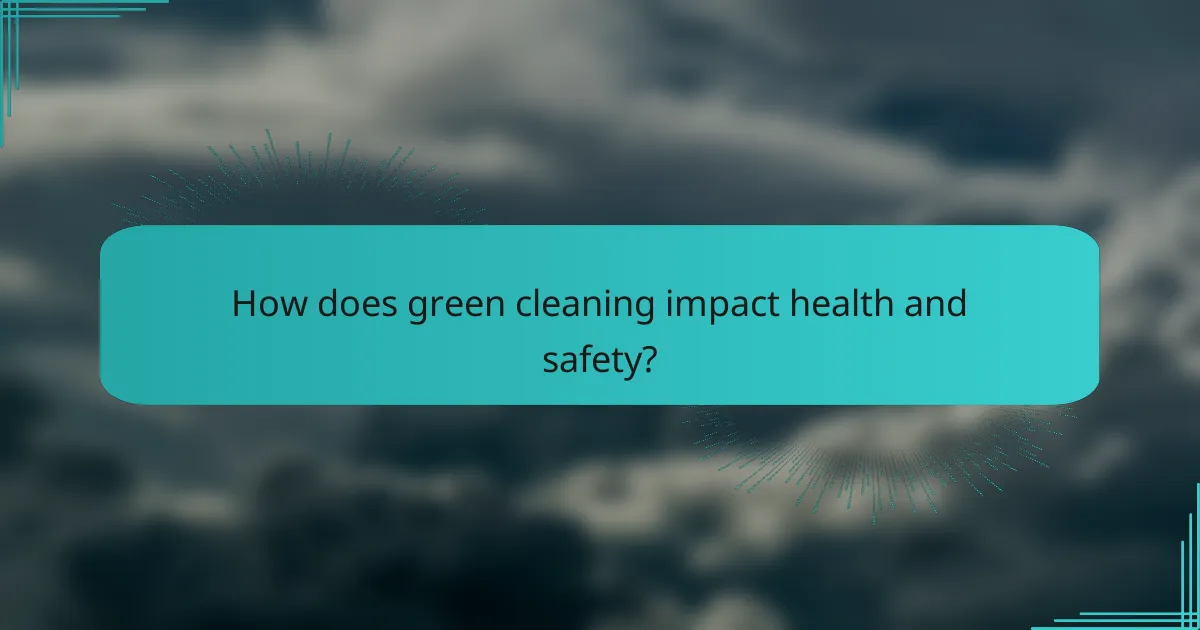Implementing green cleaning in Australian businesses is essential for promoting health and environmental sustainability. This process encompasses comprehensive staff training, careful selection of eco-friendly products, and ongoing evaluation of cleaning effectiveness to ensure optimal results.

How to implement green cleaning in Australian businesses?
Implementing green cleaning in Australian businesses involves adopting eco-friendly cleaning practices that prioritize health and environmental sustainability. This process includes training staff, selecting appropriate products, and evaluating the effectiveness of the cleaning methods used.
Step-by-step training procedures
Begin by educating staff on the principles of green cleaning, emphasizing its benefits for health and the environment. Conduct workshops that cover safe handling of green products, proper cleaning techniques, and the importance of reducing waste.
Next, provide hands-on training sessions where employees can practice using green cleaning products and equipment. Include demonstrations of effective cleaning methods that minimize chemical use and maximize efficiency.
Finally, establish a feedback loop where staff can share their experiences and suggestions for improvement. Regular refresher courses can help maintain knowledge and adapt to new green cleaning practices.
Key product selection criteria
When selecting green cleaning products, prioritize those that are certified by reputable organizations, such as Green Seal or EcoLogo. Look for products that are biodegradable, non-toxic, and free from harmful chemicals like phosphates and VOCs.
Consider the product’s effectiveness in comparison to traditional cleaners. Conduct trials to assess cleaning performance, ensuring that the chosen products meet the specific needs of your business environment.
Additionally, evaluate packaging for sustainability. Opt for products with minimal or recyclable packaging to further reduce environmental impact.
Common challenges and solutions
One common challenge is resistance from staff accustomed to traditional cleaning methods. To address this, provide clear communication about the benefits of green cleaning and involve employees in the transition process.
Another challenge is the perception that green products are less effective. Counter this by showcasing successful case studies and providing training that demonstrates the efficacy of green cleaning solutions.
Finally, budget constraints may limit product options. Explore bulk purchasing or local suppliers to find cost-effective green cleaning solutions that fit within your budget while maintaining quality.

What training procedures are effective for green cleaning?
Effective training procedures for green cleaning focus on educating staff about eco-friendly practices, product usage, and safety measures. Implementing structured onboarding programs and hands-on workshops enhances understanding and compliance with green cleaning protocols.
Onboarding programs for staff
Onboarding programs should introduce new employees to the principles of green cleaning, including the importance of sustainability and health. These programs can include a mix of online modules and in-person sessions to cover topics like eco-friendly products, waste management, and energy conservation.
Consider incorporating quizzes or interactive elements to reinforce learning. Providing a clear outline of expectations and responsibilities regarding green cleaning practices helps ensure that staff understand their role in maintaining a sustainable environment.
Hands-on workshops and demonstrations
Hands-on workshops allow staff to practice green cleaning techniques using eco-friendly products. Demonstrations can showcase proper cleaning methods, equipment usage, and safety protocols, making the training more engaging and effective.
Include practical exercises where employees can apply what they’ve learned, such as cleaning a designated area using green products. This experiential learning solidifies knowledge and boosts confidence in using sustainable cleaning methods.

Which products are best for green cleaning?
The best products for green cleaning are those that are non-toxic, biodegradable, and made from renewable resources. Look for items that effectively clean surfaces while minimizing environmental impact and health risks.
Eco-friendly cleaning brands
Several brands are recognized for their commitment to eco-friendly cleaning products. Brands like Seventh Generation, Method, and Ecover offer a range of cleaning solutions that prioritize sustainability and safety. These products often use plant-based ingredients and avoid harsh chemicals.
When selecting a brand, consider their transparency regarding ingredient sourcing and environmental practices. Many eco-friendly brands also provide refill options to reduce waste.
Certification standards for green products
Certification standards help consumers identify truly green cleaning products. Look for labels such as Green Seal, EcoLogo, and the EPA’s Safer Choice, which indicate that a product meets specific environmental and health criteria. These certifications often assess factors like toxicity, biodegradability, and resource conservation.
Understanding these standards can guide your purchasing decisions and ensure you choose products that align with your green cleaning goals. Always check for certifications on product labels for assurance.
Cost-effective product options
Cost-effective green cleaning options include both commercial products and DIY solutions. Many eco-friendly brands offer competitively priced items, often in bulk or refillable formats, which can save money over time. Additionally, common household ingredients like vinegar, baking soda, and lemon juice can be combined to create effective cleaning solutions.
When considering cost, evaluate the long-term savings from using concentrated products that require less frequent repurchasing. Avoiding single-use plastics by opting for refillable containers can also contribute to cost savings and environmental benefits.

How to evaluate the effectiveness of green cleaning?
Evaluating the effectiveness of green cleaning involves assessing its performance through specific metrics and gathering feedback from users. This process ensures that the cleaning methods and products used meet environmental standards while maintaining cleanliness and safety.
Performance metrics and KPIs
Performance metrics and key performance indicators (KPIs) are essential for measuring the success of green cleaning initiatives. Common metrics include cleaning efficiency, reduction in chemical usage, and overall satisfaction ratings from users. For instance, tracking the time taken to clean a space can help identify improvements or areas needing attention.
Another useful KPI is the level of indoor air quality, which can be measured using air quality monitors. A significant improvement in air quality post-cleaning can indicate the effectiveness of green cleaning products compared to traditional ones. Aim for a reduction in volatile organic compounds (VOCs) and other pollutants as a benchmark.
Feedback mechanisms from staff and clients
Collecting feedback from staff and clients is crucial for evaluating green cleaning effectiveness. Surveys and interviews can provide insights into user experiences and satisfaction levels. Consider implementing a regular feedback loop, such as quarterly surveys, to gauge perceptions of cleanliness and any noticeable changes in health or comfort.
Additionally, establishing a reporting system for staff to communicate issues or concerns can enhance the evaluation process. This could include a simple online form where employees can log their observations about cleaning effectiveness or any adverse reactions to cleaning products. Regularly reviewing this feedback will help refine cleaning practices and product selections.

What are the prerequisites for green cleaning implementation?
Implementing green cleaning requires a clear understanding of existing practices, stakeholder involvement, and the selection of appropriate eco-friendly products. These prerequisites ensure a smooth transition to sustainable cleaning methods that are effective and compliant with environmental standards.
Assessment of current cleaning practices
Begin by evaluating your current cleaning methods, products, and frequency. Identify which chemicals are used, their potential environmental impact, and any existing waste management practices. This assessment helps pinpoint areas for improvement and guides the selection of greener alternatives.
Consider conducting surveys or audits to gather data on cleaning effectiveness and employee satisfaction. This information can provide insights into which practices are working and which need adjustment. Aim for a comprehensive review that includes input from cleaning staff and management.
Stakeholder engagement strategies
Engaging stakeholders is crucial for successful green cleaning implementation. Start by informing and educating all parties involved, including cleaning staff, management, and building occupants, about the benefits of green cleaning. Highlight how these practices can improve health, safety, and environmental impact.
Organize workshops or training sessions to foster collaboration and gather feedback. Encourage stakeholders to share their concerns and suggestions, which can lead to a more inclusive and effective transition. Regular updates and open communication will help maintain momentum and commitment to green cleaning initiatives.

How does green cleaning impact health and safety?
Green cleaning significantly enhances health and safety by reducing exposure to toxic substances and improving overall indoor environments. By using eco-friendly products and practices, organizations can create safer spaces for occupants and workers alike.
Reduction of harmful chemicals
Green cleaning focuses on using products that contain fewer harmful chemicals, which can lead to a decrease in health risks such as respiratory issues and skin irritations. Traditional cleaning agents often include volatile organic compounds (VOCs) that can contribute to long-term health problems.
When selecting green cleaning products, look for certifications like Green Seal or EcoLogo, which indicate lower toxicity levels. Avoid products with synthetic fragrances, dyes, and harsh solvents to minimize chemical exposure.
Improved indoor air quality
Implementing green cleaning practices can significantly enhance indoor air quality by reducing the number of pollutants and allergens present in the environment. This is particularly important in spaces like schools and offices where people spend extended periods indoors.
Using natural cleaning agents, increasing ventilation, and regularly maintaining HVAC systems can help achieve better air quality. Consider using air purifiers and indoor plants to further improve the atmosphere and promote a healthier workspace.

What are the emerging trends in green cleaning?
Emerging trends in green cleaning focus on sustainability, health, and efficiency. These trends include the use of eco-friendly products, innovative cleaning technologies, and practices that prioritize indoor air quality and environmental impact.
Training procedures
Effective training procedures for green cleaning emphasize the importance of using sustainable practices and products. Training should cover the proper use of eco-friendly cleaning agents, techniques for minimizing waste, and methods for maintaining indoor air quality.
Regular workshops and hands-on demonstrations can enhance understanding and retention. Incorporating feedback mechanisms allows for continuous improvement and adaptation of training materials to reflect the latest green cleaning innovations.
Product selection
Choosing the right products is crucial for successful green cleaning. Look for certifications such as Green Seal or EcoLogo, which indicate that products meet specific environmental standards. Consider the ingredients, packaging, and overall lifecycle of the products.
Prioritize multi-purpose cleaners to reduce the number of products needed. For example, a biodegradable all-purpose cleaner can effectively replace several traditional cleaners, simplifying inventory and reducing waste.
Effectiveness evaluation
Evaluating the effectiveness of green cleaning practices involves assessing both cleaning results and environmental impact. Regular inspections and feedback from staff can help determine if cleaning standards are met while maintaining sustainability goals.
Utilize metrics such as reduction in chemical usage, improvement in indoor air quality, and employee satisfaction to gauge success. Implementing a tracking system can help identify areas for improvement and ensure accountability in green cleaning efforts.


